Day 27: Rabbit Farming
Dear Student,
Rabbit production has been practiced for millennia, though it’s fallen out of favor in the United States and much of Europe (where domestic rabbits originated) over the past century.
But rabbit farming has many points for its recommendation…
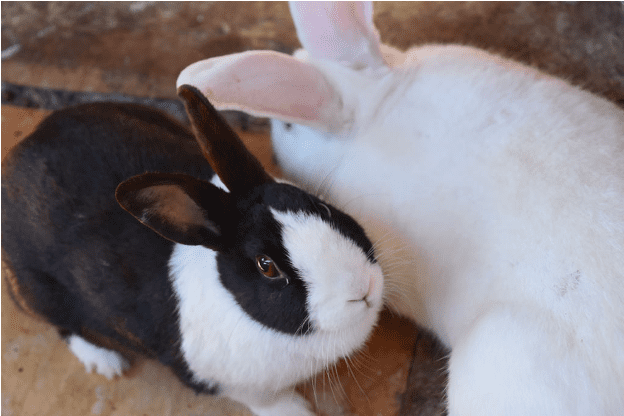 Rabbits can survive mostly on weeds.
Rabbits can survive mostly on weeds.- They are highly efficient converters of food to meat. Old timers say that a field of alfalfa will produce five times as much meat if fed to rabbits than if fed to cattle.
- They breed like, well… rabbits. One buck and two does can produce 200 pounds of meat in a year.
- They have a high killing out percentage.
- Their meat is easy to process.
- The meat is low in fat.
- Their meat is 25% higher in protein than beef.
- Rabbit manure is a great fertilizer.
- Their fur can be easily tanned into leather.
And rabbits have many advantages over other backyard animals you might choose to rear…
- They can be fully fed from on-farm waste products.
- They are silent; they don’t cause noise pollution or annoy neighbors.
- Children love them, and they can be great pets.
- They do well in confinement, so can be raised in apartments if needed.
- Their droppings are a super-rich fertilizer. Place a tray of sawdust under the cages to allow the droppings to fall through and it will naturally convert into compost with time.
Feeding
Rabbits require bulky fibrous diets and thrive on greens, legumes, grasses, vegetables, roots, and tubers. Dry does (does not being mated) eat 4% of their body weight each day. Growing rabbits under 6 months eat 7% of their body weight each day.
During summer, rabbits can forage for all their food in a free-range paddock or in portable hutches similar to chicken tractors. (The fencing on any rabbit paddock should be buried 6 inches into the ground to prevent them burrowing out.)
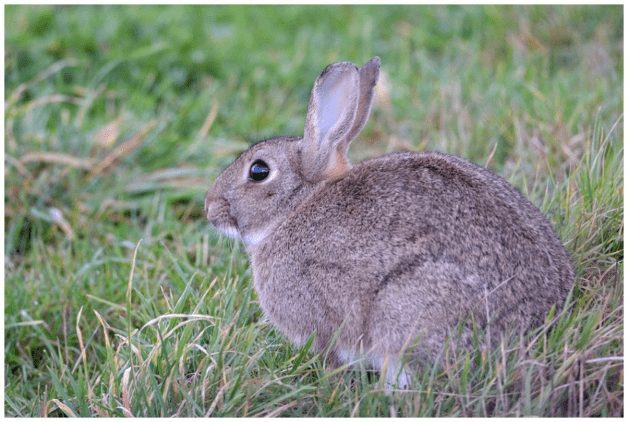 During winter or in mainly cold climates, you can either collect forage feed for them and carry it into their hutches or you can give them concentrates (food pellets).
During winter or in mainly cold climates, you can either collect forage feed for them and carry it into their hutches or you can give them concentrates (food pellets).
Good-quality legume hay (as opposed to grass hay) should be a large part of any rabbit’s diet. Grasses and greens are high in water, so it’s hard for fast-growing rabbits to eat enough for optimal weight gain. Luckily, legume hay is cheap to buy or easy to make yourself. A good leguminous hay like alfalfa is a great choice, along with fresh grass and weeds.
Does should not be given any more hay starting from 18 days after mating; at this point, they should be given only concentrates. After giving birth, allow her free access to all the food she wants up to 8 ounces per day.
Rabbit feed pellets are handy and inexpensive but are not strictly necessary for rabbits that aren’t being bred.
Natural feeding is free but requires effort to collect the weeds and greens. If you opt for pellets, you can feed up to 3 ounces of concentrates and all-they-can-eat hay to all rabbits over 8 weeks old.
If you want to make your own concentrate, try these mixes…
Rabbit Feed Concentrate For General Use:
- 5 lbs. whole barley or oats
- 25 lbs. alfalfa or clover hay 3
- 25 lbs. salt
Rabbit Feed Concentrate For Pregnant And Nursing Does:
- 5 lbs. whole oats or wheat
- 5 lbs. whole barley, milo, or other grain sorghum
- 10 lbs. soybean pellets (38 to 43% protein)
- 75 lbs. alfalfa or clover hay
- 25 lbs. salt
Housing
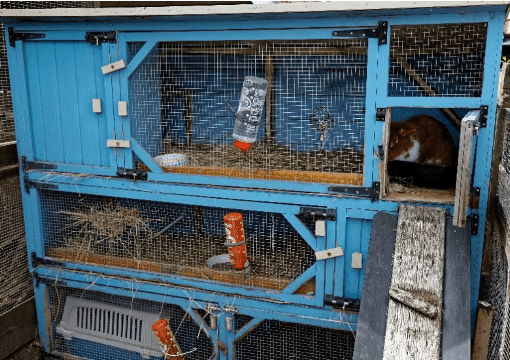
Rabbits can be confined to their hutches all their life with much less stress than confinement chickens as long as fresh greens and forage are brought to them.
Rabbits need dry environments, so be sure their nest boxes aren’t prone to dampness, and give them free access to clean bedding (shredded newspaper or cardboard, sawdust, soft wood shavings like pine, straw, hay, etc.).
Shelter should be safe from predators, too.

A raised hutch with a wire mesh or slatted floor provides both protection and a self-cleaning function (droppings fall through onto the ground or into a collection pan below).
Breeding
Rabbit does are unusual in they are always receptive to mating when not pregnant; the act of mating actually brings them in season.
For maximum efficiency, a doe should be carried to a buck’s hutch six weeks after giving birth (or at five or six months old if it’s the first mating). Simply place the doe in with the buck (don’t bring the buck to the doe; she will fight him to protect her hutch and any offspring she has). Mating will commence within a few minutes if all is in order. If it doesn’t, remove her after 10 minutes and bring her back the next day.
Gestation takes about 30 days, and litters range from 3 to 15 young, with 10 being the typical average. Put the doe in her own nest box on day 29 so she can pull fur, a natural process by which the doe’s fur loosens, and she pulls it off to build a nest for her babies.
A healthy doe can easily produce 50 offspring in a year. With practice, you can get six litters per year per doe.
Rabbits usually don’t have any problems getting pregnant, but to ensure you don’t put a pregnant doe in with a buck (and cause a fight) you should palpate her 10 or so days after mating. There are plenty of instructional videos on YouTube showing you just how to palpate a rabbit, and it’s not difficult.
Palpating A Rabbit:
- Hold or place the rabbit with her head facing towards you.
- Slide your right hand under the rabbit with your palm facing up.
- Lift her lower abdomen and squeeze gently.
- Feel for a line of grape-like lumps running down one or both sides of her abdomen—these are the babies. If the lumps run down the middle of the abdomen these lumps might just be faeces in her gut, and if there’s nothing else to either side, she’s not pregnant.
You should keep some of the litter for future breeding stock, but be sure to remove the females to their own hutches at 3 months old to prevent early breeding.
Young rabbits are ready to be processed (butchered) at weaning (8 weeks). They will provide a carcass weighing 3 to 4 pounds and are at their most tender at this age. The next litter will be born about 17 days after the last litter is processed (with gestation taking about 30 days).
Choosing A Rabbit Breed To Rear
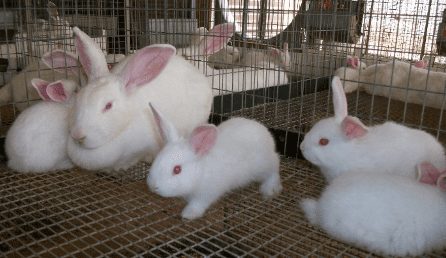
The New Zealand white and the Californian rabbit are the two breeds that are most popular and recommended for commercial rearing. These medium-to-large breeds are the best breeders and food converters in the industry.
Adults of these breeds will achieve weights of 8 to 12 pounds when fully grown. Less efficient breeds like the Flemish Giant can grow to over 20 pounds.
Slaughtering
The killing and cleaning process is easier for rabbits than just about any other animal you might rear.
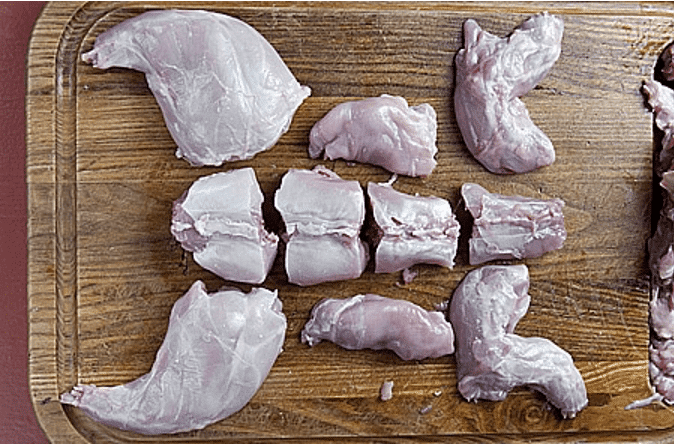
- Pick the rabbit up by its back legs in your left hand.
- Grab the rabbit’s head in your right hand and twist backwards until the neck snaps.
- Pull to stretch the neck.
- Hang the hind legs on two hooks just above the feet.
- Making a cut just above the hock (knee) joints on the hind legs and slit the skin on the inside of the joint up to the anus (fig. 1 in the diagram below).
- Peeling the skin off the hind legs, grab the hind legs and the loose leg skin and peel the entire skin off the rabbit like you would pull a sock or a glove off (it turns inside out). (figs. 2, 3, 4).
- Gut gently by cutting from the rib cage to the navel and remove everything except the kidneys and liver (fig. 5).
- Discard the head.
- Chop off the legs and split the body in four or more pieces in preparation for cooking (see picture below diagram).

